Category: Scale-Out Storage
The Ins and Outs of a Scale-Out File System Architecture
Networking Questions for Ethernet Scale-Out Storage
 Unlike traditional local or scale-up storage, scale-out storage imposes different and more intense workloads on the network. That’s why the SNIA Networking Storage Forum (NSF) hosted a live webcast “Networking Requirements for Ethernet Scale-Out Storage.” Our audience had some insightful questions. As promised, our experts are answering them in this blog.
Q. How does scale-out flash storage impact Ethernet networking requirements?
A. Scale-out flash storage demands higher bandwidth and lower latency than scale-out storage using hard drives. As noted in the webcast, it’s more likely to run into problems with TCP Incast and congestion, especially with older or slower switches. For this reason it’s more likely than scale-out HDD storage to benefit from higher bandwidth networks and modern datacenter Ethernet solutions–such as RDMA, congestion management, and QoS features. Read More
Unlike traditional local or scale-up storage, scale-out storage imposes different and more intense workloads on the network. That’s why the SNIA Networking Storage Forum (NSF) hosted a live webcast “Networking Requirements for Ethernet Scale-Out Storage.” Our audience had some insightful questions. As promised, our experts are answering them in this blog.
Q. How does scale-out flash storage impact Ethernet networking requirements?
A. Scale-out flash storage demands higher bandwidth and lower latency than scale-out storage using hard drives. As noted in the webcast, it’s more likely to run into problems with TCP Incast and congestion, especially with older or slower switches. For this reason it’s more likely than scale-out HDD storage to benefit from higher bandwidth networks and modern datacenter Ethernet solutions–such as RDMA, congestion management, and QoS features. Read More
How Scale-Out Storage Changes Networking Demands
SNIA Storage Developer Conference-The Knowledge Continues
SNIA’s 18th Storage Developer Conference is officially a success, with 124 general and breakout sessions; Cloud Interoperability, Kineti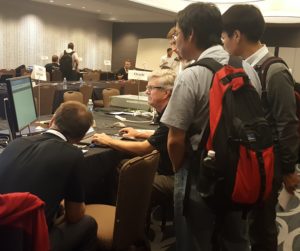 c Storage, and SMB3 plugfests; ten Birds-of-a-Feather Sessions, and amazing networking among 450+ attendees. Sessions on NVMe over Fabrics won the title of most attended, but Persistent Memory, Object Storage, and Performance were right behind. Many thanks to SDC 2016 Sponsors, who engaged attendees in exciting technology discussions.
c Storage, and SMB3 plugfests; ten Birds-of-a-Feather Sessions, and amazing networking among 450+ attendees. Sessions on NVMe over Fabrics won the title of most attended, but Persistent Memory, Object Storage, and Performance were right behind. Many thanks to SDC 2016 Sponsors, who engaged attendees in exciting technology discussions.
For those not familiar with SDC, this technical industry event is designed for a variety of storage technologists at various levels from developers to architects to product managers and more. And, true to SNIA’s commitment to educating the industry on current and future disruptive technologies, SDC content is now available to all – whether you attended or not – for download and viewing.
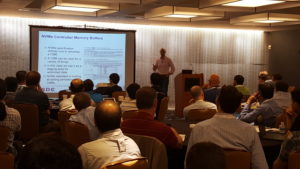 You’ll want to stream keynotes from Citigroup, Toshiba, DSSD, Los Alamos National Labs, Broadcom, Microsemi, and Intel – they’re available now on demand on SNIA’s YouTube channel, SNIAVideo.
You’ll want to stream keynotes from Citigroup, Toshiba, DSSD, Los Alamos National Labs, Broadcom, Microsemi, and Intel – they’re available now on demand on SNIA’s YouTube channel, SNIAVideo.
All SDC presentations are now available for download; and over the next few months, you can continue to download SDC podcasts which combine audio and slides. The first podcast from SDC 2016 – on hyperscaler (as well as all 2015 SDC Podcasts) are available here, and more will be available in the coming weeks.
SNIA thanks all its members and colleagues who contributed to make SDC a success! A special thanks goes out to the SNIA Technical Council, a select group of acknowledged industry experts who work to guide SNIA technical efforts. In addition to driving the agenda and content for SDC, the Technical Council oversees and manages SNIA Technical Work Groups, reviews architectures submitted by Work Groups, and is the SNIA’s technical liaison to standards organizations. Learn more about these visionary leaders at http://www.snia.org/about/organization/tech_council.
And finally, don’t forget to mark your calendars now for SDC 2017 – September 11-14, 2017, again at the Hyatt Regency Santa Clara. Watch for the Call for Presentations to open in February 2017.
The Changing World of SNIA Technical Work – A Conversation with Technical Council Chair Mark Carlson
 Mark Carlson is the current Chair of the SNIA Technical Council (TC). Mark has been a SNIA member and volunteer for over 18 years, and also wears many other SNIA hats. Recently, SNIA on Storage sat down with Mark to discuss his first nine months as the TC Chair and his views on the industry.
Mark Carlson is the current Chair of the SNIA Technical Council (TC). Mark has been a SNIA member and volunteer for over 18 years, and also wears many other SNIA hats. Recently, SNIA on Storage sat down with Mark to discuss his first nine months as the TC Chair and his views on the industry.
SNIA on Storage (SoS): Within SNIA, what is the most important activity of the SNIA Technical Council?
Mark Carlson (MC): The SNIA Technical Council works to coordinate and approve the technical work going on within SNIA. This includes both SNIA Architecture (standards) and SNIA Software. The work is conducted within 13 SNIA Technical Work Groups (TWGs). The members of the TC are elected from the voting companies of SNIA, and the Council also includes appointed members and advisors as well as SNIA regional affiliate advisors. 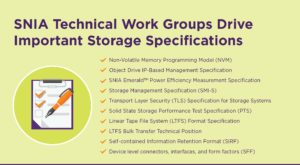
SoS: What has been your focus this first nine months of 2016?
MC: The SNIA Technical Council has overseen a major effort to integrate a new standard organization into SNIA. The creation of the new SNIA SFF Technology Affiliate (TA) Technical Work Group has brought in a very successful group of folks and standards related to storage connectors and transceivers. This work group, formed in June 2016, carries forth the longstanding SFF Committee work efforts that has operated since 1990 until mid-2016. In 2016, SFF Committee leaders transitioned the organizational stewardship to SNIA, to operate under a special membership class named Technology Affiliate, while retaining the long standing technical focus on specifications in a similar fashion as all SNIA TWGs do.
SoS: What changes did SNIA implement to form the new Technology Affiliate membership class and why?
MC: The SNIA Policy and Procedures were changed to account for this new type of membership. Companies can now join an Affiliate TWG without having to join SNIA as a US member. Current SNIA members who want to participate in a Technology Affiliate like SFF can join a Technology Affiliate and pay the separate dues. The SFF was a catalyst – we saw an organization looking for a new home as its membership evolved and its leadership transitioned. They felt SNIA could be this home but we needed to complete some activities to make it easier for them to seamlessly continue their work. The SFF is now fully active within SNIA and also working closely with T10 and T11, groups that SNIA members have long participated in.
SoS: Is forming this Technology Affiliate a one-time activity?
MC: Definitely not. The SNIA is actively seeking organizations who are looking for a structure that SNIA provides with IP policies, established infrastructure to conduct their work, and 160+ leading companies with volunteers who know storage and networking technology.
SoC: What are some of the customer pain points you see in the industry?
MC: Critical pain points the TC has started to address with new TWGs over the last 24 months include: performance of solid state storage arrays, where the SNIA Solid State Storage Systems (S4) TWG is working to identify, develop, and coordinate system performance standards for solid state storage systems; and object drives, where work is being done by the Object Drive TWG to identify, develop, and coordinate standards for object drives operating as storage nodes in scale out storage solutions. With the number of different future disk drive interfaces emerging that add value from external storage to in-storage compute, we want to make sure they can be managed at scale and are interoperable.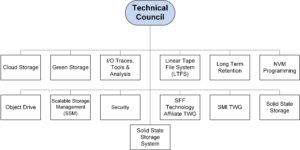
SoS: What’s upcoming for the next six months?
MC: The TC is currently working on a white paper to address data center drive requirements and the features and existing interface standards that satisfy some of those requirements. Of course, not all the solutions to these requirements will come from SNIA, but we think SNIA is in a unique position to bring in the data center customers that need these new features and work with the drive vendors to prototype solutions that then make their way into other standards efforts. Features that are targeted at the NVM Express, T10, and T13 committees would be coordinated with these customers.
SoS: Can non-members get involved with SNIA?
MC: Until very recently, if a company wanted to contribute to a software project within SNIA, they had to become a member. This was limiting to the community, and cut off contributions from those who were using the code, so SNIA has developed a convenient Contributor License Agreement (CLA) for contributions to individual projects. This allows external contributions but does not change the software licensing. The CLA is compatible with the IP protections that the SNIA IP Policy provides to our members. Our hope is that this will create a broader community of contributors to a more open SNIA, and facilitate open source project development even more.
SoS: Will you be onsite for the upcoming SNIA Storage Developer Conference (SDC)?
MC: Absolutely! I look forward to meeting SNIA members and colleagues September 19-22 at the Hyatt Regency Santa Clara. We have a great agenda, now online, that the TC has developed for this, our 18th conference, and registration is now open. SDC brings in more than 400 of the leading storage software and hardware developers, storage product and solution architects, product managers, storage product quality assurance engineers, product line CTOs, storage product customer support engineers, and in–house IT development staff from around the world. If technical professionals are not familiar with the education and knowledge that SDC can provide, a great way to get a taste is to check out the SDC Podcasts now posted, and the new ones that will appear leading up to SDC 2016.
Podcasts Bring the Sounds of SNIA’s Storage Developer Conference to Your Car, Boat, Train, or Plane!
SNIA’s Storage Developer Conference (SDC) offers exactly what a developer of cloud, solid state, security, analytics, or big data applications is looking for – rich technical content delivered in a no-vendor bias manner by today’s leading technologists. The 2016 SDC agenda is being compiled, but now you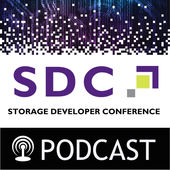 can get a “sound bite” of what to expect by downloading SDC podcasts via iTunes, or visiting the SDC Podcast site at http://www.snia.org/podcasts to download the accompanying slides and/or listen to the MP3 version.
can get a “sound bite” of what to expect by downloading SDC podcasts via iTunes, or visiting the SDC Podcast site at http://www.snia.org/podcasts to download the accompanying slides and/or listen to the MP3 version.
Each podcast has been selected by the SNIA Technical Council from the 2015 SDC event, and include topics like:
- Preparing Applications for Persistent Memory from Hewlett Packard Enterprise
- Managing the Next Generation Memory Subsystem from Intel Corporation
- NVDIMM Cookbook – a Soup to Nuts Primer on Using NVDIMMs to Improve Your Storage Performance from AgigA Tech and Smart Modular Systems
- Standardizing Storage Intelligence and the Performance and Endurance Enhancements It Provides from Samsung Corporation
- Object Drives, a New Architectural Partitioning from Toshiba Corporation
- Shingled Magnetic Recording- the Next Generation of Storage Technology from HGST, a Western Digital Company
- SMB 3.1.1 Update from Microsoft
Eight podcasts are now available, with new ones added each week all the way up to SDC 2016 which begins September 19 at the Hyatt Regency Santa Clara. Keep checking the SDC Podcast website, and remember that registration is now open for the 2016 event at http://www.snia.org/events/storage-developer/registration. The SDC conference agenda will be up soon at the home page of http://www.storagedeveloper.org.
Enjoy these great technical sessions, no matter where you may be!
Congestion Control in New Storage Architectures Q&A
We had a great response to last week’s Webcast “Controlling Congestion in New Storage Architectures” where we introduced CONGA, a new congestion control mechanism that is the result of research at Stanford University. We had many good questions at the live event and have complied answers for all of them in this blog. If you think of additional questions, please feel free to comment here and we’ll get back to you as soon as possible.
Q. Isn’t the leaf/spine network just a Clos network? Since the network has loops, isn’t there a deadlock hazard if pause frames are sent within the network?
A. CLOS/Spine-Leaf networks are based on routing, which has its own loop prevention (TTLs/RPF checks).
Q. Why isn’t the congestion metric subject to the same delays as the rest of the data traffic?
A. It is, but since this is done in the data plane with 40/100g within a data center fabric it can be done in near real time and without the delay of sending it to a centralized control plane.
Q. Are packets dropped in certain cases?
A. Yes, there can be certain reasons why a packet might be dropped.
Q. Why is there no TCP reset? Is it because the Ethernet layer does the flowlet retransmission before TCP has to do a resend?
A. There are many reasons for a TCP reset, CONGA does not prevent them, but it can help with how the application responds to a loss. If there is a loss of the flowlet it is less detrimental to how the application performs because it will resend what it has lost versus the potential for full TCP connection to be reset.
Q. Is CONGA on an RFC standard track?
A. CONGA is based on research done at Stanford. It is not currently an RFC.
The research information can be found here.
Q. How does ECN fit into CONGA?
A. ECN can be used in conjunction with CONGA, as long as the host/networking hardware supports it.